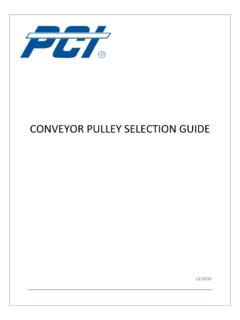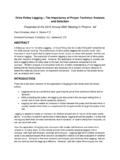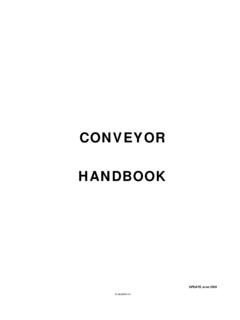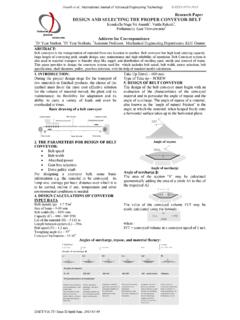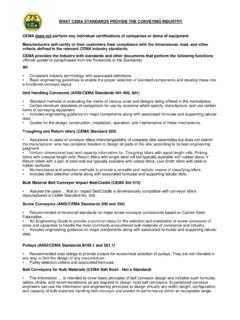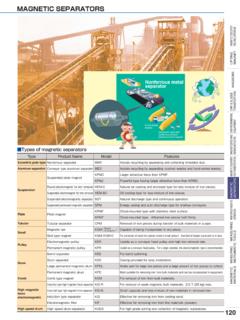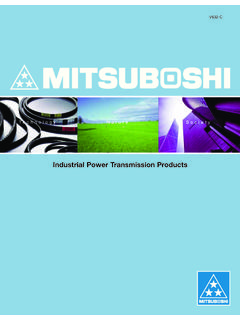Transcription of CONVEYOR PULLEY SELECTION GUIDE - pcimfg.com
1 CONVEYOR PULLEY SELECTION GUIDE 11/2014 2 CONVEYOR PULLEY SELECTION GUIDE TABLE OF CONTENTS Section Title Page Number INTRODUCTION 3 CONVEYOR PULLEY BASICS 4 CONVEYOR PULLEY TERMINOLOGY 5 STEPS FOR PROPER SELECTION 6 STEP 1: DETERMINE THE FACE LENGTH 7 STEP 2: DETERMINE THE BELT TENSION 8 STEP 3: DETERMINE THE OUTER DIAMETER & SHAFT DIAMETER 9 STEP 4: DETERMINE THE HUB CONNECTION 12 STEP 5: DETERMINE THE CONFIGURATION 17 STEP 6: DETERMINE THE PROFILE 20 STEP 7: DETERMINE THE MATERIALS 22 STEP 8: DETERMINE THE CONTACT SURFACE 23 STEP 9.
2 OTHER SPECIFICATIONS TO CONSIDER 25 INDEX 29 APPENDIX A 31 APPENDIX B 33 3 CONVEYOR PULLEY SELECTION GUIDE TOPICS COVERED IN THIS DOCUMENT INCLUDE DETERMINATION OF SYSTEM LOADS Catenary Load Take-Up Tension Product Load and Loading Method PULLEY Weight PULLEY Position PULLEY SIZING Selecting a PULLEY Face Length Selecting PULLEY Diameter and Shaft Diameter Wall & End Disk SELECTION PULLEY CONSTRUCTION Hub Styles Axle Details Common Configurations Common Profiles Contact Surfaces (Lagging, Knurling) Material SELECTION Performance Requirements (Runout versus Concentricity) INTRODUCTION CONVEYOR pulleys play an essential role in the performance and reliability of belt CONVEYOR systems worldwide.
3 It is because of this essential role that PULLEY SELECTION becomes a critical process in keeping equipment up and running. If SELECTION is conducted in haste, a CONVEYOR PULLEY may be inadequately sized and selected, leading to premature PULLEY failure and costly downtime. This document is a step-by-step GUIDE through the process of PULLEY SELECTION . This SELECTION GUIDE is designed to assist in identifying and determining system loads so that PULLEY SELECTION addresses the important variables in an application and is conducted as efficiently as possible. 4 CONVEYOR PULLEY SELECTION GUIDE CONVEYOR PULLEY BASICS CONVEYOR pulleys are designed for use on belt CONVEYOR systems as a means to drive, redirect, provide tension to, or help track the CONVEYOR belt.
4 CONVEYOR pulleys are not designed for the same application intent as CONVEYOR rollers. CONVEYOR rollers are designed to be used in the bed of a CONVEYOR as a support for the conveyed product and often under the CONVEYOR bed in the return section to support the return side of the CONVEYOR belt. Drive/Head PULLEY A CONVEYOR PULLEY used for the purpose of driving a CONVEYOR belt. Typically mounted in external bearings and driven by an external drive source. Idler PULLEY Any PULLEY used in a non-drive position that is intended to rotate freely and be driven by the belt. Return/Tail PULLEY A CONVEYOR PULLEY used for the purpose of redirecting a CONVEYOR belt back to the drive PULLEY .
5 Tail pulleys can utilize internal bearings or can be mounted in external bearings and are typically located at the end of the CONVEYOR bed. Tail pulleys commonly serve the purpose of a Take-Up PULLEY on conveyors of shorter lengths. Snub PULLEY A CONVEYOR PULLEY used to increase belt wrap around a drive PULLEY , typically for the purpose of improving traction. Take-Up PULLEY A CONVEYOR PULLEY used to remove slack and provide tension to a CONVEYOR belt. Take-Up pulleys are more common to conveyors of longer lengths. Bend PULLEY A CONVEYOR PULLEY used to redirect the belt and provide belt tension where bends occur in the CONVEYOR system. CONVEYOR Roller A product used either in the bed of a CONVEYOR as a support for the conveyed product or in the return section under the CONVEYOR bed as a support for the CONVEYOR belt 5 CONVEYOR PULLEY SELECTION GUIDE PULLEY /Core Diameter The outside diameter of the cylindrical body of a CONVEYOR PULLEY , without coating.
6 Finish Diameter The outside diameter of a coated PULLEY (core diameter + 2 times the coating/wrap thickness). Face Width The length of a PULLEY s cylindrical body. This area is intended to act as the contact surface for the CONVEYOR belt. Wall/Rim Thickness The initial thickness of the tube, pipe, or formed plate that makes up the cylindrical body of the PULLEY . End Disks The plates welded on the ends of a PULLEY which act as the medium between the hub and rim. Crown/Profile A change in the shape of the PULLEY face designed for the purpose of enhancing belt tracking. Shaft/Axle The mounting mechanism for the PULLEY assembly. Hub The point of connection between the shaft and end disk or PULLEY wall.
7 Bore Diameter The inner diameter of a PULLEY at the point where the shaft is inserted Bearing Centers The distance between the center lines of each bearing race in which a PULLEY is mounted. Hub Centers The distance between the center line of each hub contact surface. Safety Factor The capacity of a system or component to perform beyond its expected load CONVEYOR PULLEY TERMINOLOGY 6 CONVEYOR PULLEY SELECTION GUIDE PROPER SELECTION OF A CONVEYOR PULLEY When selecting a PULLEY for a belt CONVEYOR application, specifications will be determined by addressing the following steps: STEP 1 The Face Length of the CONVEYOR PULLEY STEP 2 The Anticipated Belt Tension of the CONVEYOR System STEP 3 The Outer Diameter & Shaft Diameter of the CONVEYOR PULLEY STEP 4 The Style of Hub Connection STEP 5 The PULLEY Configuration STEP 6 The Profile of the PULLEY Face STEP 7 The Appropriate Component Materials STEP 8 The Type of Contact Surface Required STEP 9 Other Important Specifications 7 CONVEYOR PULLEY SELECTION GUIDE STEP #1: Determine the Face Length of the CONVEYOR PULLEY The face length of a CONVEYOR PULLEY is a derivative of the CONVEYOR belt width.
8 In bulk handling applications, an adequate PULLEY face length is one that is 2 or 3 greater overall or 1 to greater on each end than the overall width of the CONVEYOR belt. Unit handling applications may warrant deviation from these guidelines. 8 CONVEYOR PULLEY SELECTION GUIDE STEP #2: Determine the Anticipated Belt Tension of the CONVEYOR System Belt tension measures the degree to which the CONVEYOR belt is stretched or held taut and is typically measured in pounds per inch width (PIW). CONVEYOR pulleys and shafts of a larger diameter are better equipped to handle elevated levels of belt tension. Belt tension is applied to the CONVEYOR system by the following sources: Conveyed Load: The weight of the product that is being conveyed produces a resisting force which will fight against the forward motion of the CONVEYOR belt, therefore providing additional belt tension to the CONVEYOR system.
9 The amount of tension produced by the conveyed product is dependent on the amount, size, and type of the product being conveyed, as well as how the belt is supported on the loaded side, considering the variance in coefficient of friction between slider and roller bed CONVEYOR systems. Catenary Load: The mechanism designed to support the weight of the CONVEYOR belt in the return section of a CONVEYOR will impact the amount of tension experienced by the pulleys . This type of belt tension is produced by catenary load which is a byproduct of the level of catenary sag existing in a CONVEYOR belt. If the CONVEYOR belt is under-supported on its return side, the weight of the belt in that section is supported by the pulleys as a catenary load, and greater belt tension is needed to prevent excessive sagging.
10 Belt return support rollers should be spaced so that the belt does not sag excessively between each roller. The schematics below illustrate the concept of catenary load: The Take-Up Mechanism: The amount of belt tension on a CONVEYOR system may require belt slack adjustment during installation procedures, during normal operation for belt tracking purposes, or for disassembly purposes during maintenance procedures. The term Take-Up refers to a variety of devices that are used to provide adjustment in the amount of belt tension on a CONVEYOR system. Since many of these devices require manual calibration, adjustment of belt tension with a take-up mechanism requires training and an understanding of how belt tension affects CONVEYOR load.
